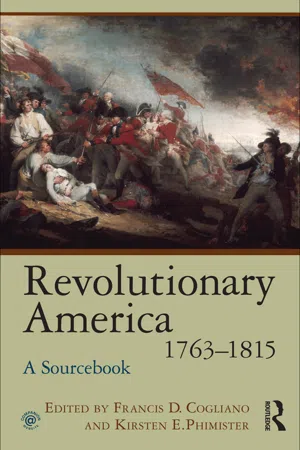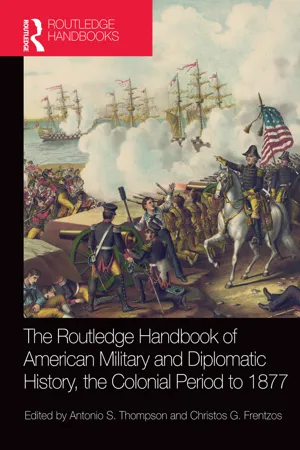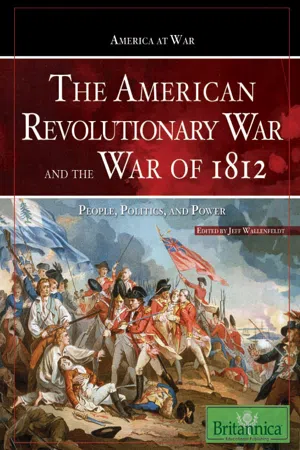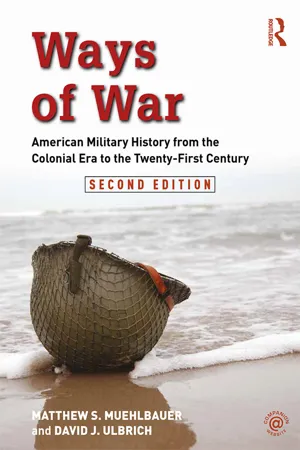Battles of the American Revolution
The Battles of the American Revolution were a series of military engagements fought between the American colonies and Great Britain from 1775 to 1783. Key battles included Lexington and Concord, Bunker Hill, Saratoga, and Yorktown. These battles were pivotal in shaping the outcome of the war and ultimately led to the independence of the United States from British rule.
6 Key excerpts on "Battles of the American Revolution"
- eBook - ePub
From Lexington to Baghdad and Beyond
War and Politics in the American Experience
- Donald M Snow, Dennis M. Drew(Authors)
- 2015(Publication Date)
- Routledge(Publisher)
...2 AMERICAN REVOLUTION The American Revolution was this country’s great formative act. Along with the Civil War, the Revolution stands as the most influential military event in American history in terms of its political purposes and political impact. Although it was not particularly recognized at the time it was being fought, the Revolution also marked an important turning point in international politics: it was both the first major war of independence against European colonial domination and the conflict that reintroduced ideology into the underlying causes and sustainers of warfare. In purely military terms, the Revolution pales in comparison to the great struggles that began with the Civil War and continued into the twentieth century. The armies that contested the war were tiny by modem standards; at its apex, the British had a force numbering about 32,000 on colonial soil, and George Washington’s Continental Army never numbered more than 20,000. Battles were relatively few and comparatively bloodless, reflecting the eighteenth-century style of warfare. In the climactic Battle of Yorktown (which is more properly the Siege at Yorktown) an army of 16,000 Continentals and French marines in about equal numbers faced a British force of about 7,500 under Lord Cornwallis. When the British surrendered, the battlefield toll was slightly more than 200 killed, of whom only 20 were American. The Revolution also continued the American mythology about the American military tradition begun in the French and Indian War. Yorktown, Saratoga, Trenton, Princeton, King’s Mountain, and other fields of battle have become symbols of the tradition of military prowess and the American self-image as winners. That most of these battles were not as successful as we remember them, nor as militarily significant, and that they were interspersed with a series of military reverses that were nearly decisive, (e.g., the battles of New York and Brandywine Creek) have faded from the popular mind...
- eBook - ePub
Revolutionary America, 1763-1815
A Sourcebook
- Francis D. Cogliano, Kirsten E. Phimister, Francis D. Cogliano, Kirsten E. Phimister(Authors)
- 2010(Publication Date)
- Routledge(Publisher)
...CHAPTER 5 Winning Independence The Wars of the American Revolution Introduction The War of Independence was the decisive turning point in British-American relations. Once British Americans and Britons began killing each other, compromise over the political and constitutional issues became infinitely more difficult. Ultimately, the rebel victory in the prolonged and bloody struggle confirmed the independence which Congress declared in July 1776. Britain recognized the independence of the United States in the 1783 Peace of Paris which changed the course of international relations (document 8). The early days of the conflict were marked by uncertainty as the rebels undertook an ad hoc siege of the British in Boston (documents 1, 2, 4). Soon the rebels realized that they would have to raise a standing army if they were to win their independence (documents 1, 4, 6). Although the war featured regular soldiers from Britain, North America, and mainland Europe engaging in set-piece battles, it was also a bloody civil war which pitted British Americans against each other, leading to unprecedented violence and intimidation involving civilians, militias and irregular soldiers (documents 3 and 5). Loyalists and suspected loyalists were subject to physical intimidation and were sometimes killed. Some, like Samuel Curwen, went into exile during the war (document 9). Curwen’s experience underscores the fact that the War of Independence, like all wars, was experienced by individuals each of whom had their own story to tell. The letters of William Russell—soldier, privateersman, and British prisoner provide an insight into the war from the perspective of an ordinary man caught up in extraordinary circumstances (document 7). 1. A British View of the Siege of Boston 1 In the aftermath of the fighting at Lexington and Concord, rebel militiamen subjected the British in Boston to an impromptu siege...
- eBook - ePub
The Routledge Handbook of American Military and Diplomatic History
The Colonial Period to 1877
- Christos G. Frentzos, Antonio S. Thompson, Christos G. Frentzos, Antonio S. Thompson(Authors)
- 2014(Publication Date)
- Routledge(Publisher)
...PART III The War for American Independence 1775–1783 11 THE REVOLUTIONARY WAR A Historiographical Summary Edward G. Lengel Americans debated the meaning of the Revolutionary War while its battles still raged, and sought to define its place in history as soon as the guns fell silent. In this respect it mirrored other wars. Strangely, though, the Revolutionary War has become nebulous in American historical memory. While the causes and course of the Revolution—as distinct from the Revolutionary War—seem cut and dried, interpretations of the war remain embedded in mythology. Many important aspects of the war remained unstudied until the 1950s. Innovative interpretations of broad issues in strategy, tactics and leadership did not surface until after the Vietnam era. Instead of developing improved concepts, challenges to these interpretations have often been atavistic rather than original. As the Revolutionary War’s final stages played out in October 1782, a Massachusetts minister named William Gordon approached George Washington with the idea of writing a history of the war. Washington encouraged Gordon, but noted that the “best Historiographer living” could not write such a work effectively without access to the archives of Congress and the individual states, and the papers of the commander in chief and his officers. Calling his own papers “a species of Public property, sacred in my hands,” Washington refused to grant Gordon access to them until the war had ended. 1 Gordon knocked at Mount Vernon’s door again in June 1784 and this time received Washington’s blessing to study his papers. Gordon copied dozens of volumes of the general’s letters for use in his research, and afterwards traveled in the United States and England to gather additional materials. His labors bore fruit in 1788 with the publication of The History of the Rise, Progress, and Establishment, of the Independence of the United States of America in four volumes...
- eBook - ePub
The American Revolutionary War and The War of 1812
People, Politics, and Power
- Britannica Educational Publishing, Jeff Wallenfeldt(Authors)
- 2009(Publication Date)
- Britannica Educational Publishing(Publisher)
...CHAPTER 4 T HE B ATTLES OF THE A MERICAN R EVOLUTION A t first, it seemed inevitable that the British would put a quick end to the colonists’ rebellion that had begun in Lexington and Concord on April 19, 1775. After all, the British Empire had arguably the best-trained army and mightiest navy in the world, while the American troops were poorly paid, undisciplined, and led by inexperienced generals. Indeed, Gen. George Washington made a number of serious strategic blunders in the early days of the war. Yet, the Americans had their own advantages. They knew their vast, complex terrain and capitalized on that familiarity by using guerrilla tactics. Unlike the British, the Americans were not dependent on the transatlantic shipment of men and materiel, and could fight a defensive war. Even if the British won battles and had Loyalist support, they could not win over the great majority of the people. As war destroyed lives and property in the colonies, opinion hardened against the British. Furthermore, as the fighting dragged on, opinion against the war hardened in Britain as well. Although Britain triumphed in many individual battles, this mighty, war-tested country ultimately lost the war. BATTLES OF LEXINGTON AND CONCORD Acting on orders from London to suppress the rebellious colonists, Gen. Thomas Gage, recently appointed royal governor of Massachusetts, ordered his troops to seize the colonists’ military stores at Concord. En route from Boston, on April 19, 1775, the British force of 700 men was met on Lexington Green by 77 local Minutemen and others who had been forewarned of the raid by the colonists’ efficient lines of communication, including the ride of Paul Revere. It is unclear who fired the first shot. Resistance melted away at Lexington, and the British moved on to Concord. Most of the American military supplies had been hidden or destroyed before the British troops arrived...
- eBook - ePub
Ways of War
American Military History from the Colonial Era to the Twenty-First Century
- Matthew S. Muehlbauer, David J. Ulbrich(Authors)
- 2017(Publication Date)
- Routledge(Publisher)
...Chapter 3 The American Revolution, 1763–1783 In early 1763, many people regarded Great Britain as the most powerful country in the world. It had mustered astonishingly large military forces in the Seven Years War and deployed them around the world in successful campaigns, including the conquest of Canada. With the ratification of the Peace of Paris, Great Britain ruled all of North America east of the Mississippi River. But afterward, the British government struggled to cope with the enormous debt created during the war and faced challenges in the American backcountry. Native peoples had had no say in the deliberations that ended the French and Indian War, and their territories and traditional lifestyles faced growing pressure from settlers migrating westward. These tensions erupted in Pontiac’s Rebellion of 1763, which demonstrated to officials in London the need for security in the colonies. But they imposed their policies in a heavy-handed manner that contravened the traditional light touch applied to British America prior to the Seven Years War. The result was an imperial crisis that ultimately produced a new, independent country. In this chapter, students will learn about: Factors that led to conflict between Great Britain and its North American colonies. British and American strategy in the War of the American Revolution. The major campaigns, battles, and commanders. How diplomatic, political, and logistical factors affected military operations and were in turn impacted by the outcomes of battles and campaigns. The different types of combatants and how they fought. Native Peoples and Pontiac’s War British officials and settlers’ relations with native peoples were often strained during the French and Indian War. One case involved the Cherokee, longtime allies of South Carolina. In 1758, colonists attacked warriors returning from Pennsylvania, while Carolina settlers poached game in Cherokee hunting grounds...
- eBook - ePub
- Thomas Maitland Marshall(Author)
- 2011(Publication Date)
- Perlego(Publisher)
...Ford, ed.), II-VI; Lecky, W.E.H., History of England in the Eighteenth Century, III, 461-500; Smith, J.H., Our Struggle for the Fourteenth Colony, I, 107-165; Trevelyan, G.O., The American Revolution, I, 254-390; Van Tyne, C.H., The American Revolution, 24-49; Winsor, Justin, Narrative and Critical History, VI, 1-274; Adams, C.F., Studies Military and Diplomatic, 1775-1865, pp. 1-21. THE LOYALISTS Flick, A.C., Loyalism in New York (Columbia University, Studies in History, etc., XIV, No. 1.); Tyler, M.C., "The Party of the Loyalists in the American Revolution," in The American Historical Review, I, 24-45; Van Tyne, C.H., The Loyalists in the American Revolution ; Wallace, S., The United Empire Loyalists. THE DECLARATION OF INDEPENDENCE Friedenwald, H., The Declaration of Independence ; Hazelton, J.H., The Declaration of Independence ; Trevelyan, G.O., The American Revolution, II, 133-171; Van Tyne, C.H., The American Revolution, 50-101; Becker, C.L., The Eve of the Revolution, 200-256. CHAPTER XXV THE STRUGGLE FOR THE MUDDLE STATES (1776-1777) THE CONTEST FOR NEW YORK Preparations to defend New York.—After the evacuation of Boston it was realized that New York would be a probable point of attack and great exertions were made to put it in a state of defence. Washington arrived on April 13, 1776; his troops, delayed by bad roads, came straggling in, and new levies began to arrive, the army being gradually augmented until it numbered about twenty thousand men. But the effective fighting force was several thousand less, for disease was ever present. Furthermore the raw recruits were poorly trained and equipped, and there were not enough artillerymen to man the batteries. The only cavalrymen who appeared were a small force from Connecticut and these, for reasons best known to himself, Washington did not retain in service. The defences were strengthened by works at Paulus Hook on the Jersey shore, and others on Governor's Island and at Red Hook on Long Island...





